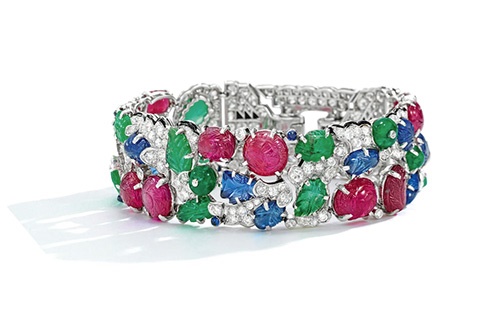A Guide to Art Deco Jewellery
Unveiling the allure and sophistication of this culturally significant jewellery
09/03/2023
A style that emerged in the early 20th century, the Art Deco movement has since become synonymous with elegance, glamour, and luxury. Spanning two decades, the Art Deco era revitalised the years after the First World War, accessorising the 1920s and 30s with bold colours, intricate designs, and geometric shapes. Adorned by the rich and famous of the era, Art Deco jewellery today continues to be highly sought after by jewellery collectors and connoisseurs alike.
At Dawsons, we are consistently seeing a great deal of interest in Art deco jewellery, and we are always looking to bring more of the most exceptional pieces to our auctions. This guide will introduce you to the exquisite features of Art Deco jewellery and the radical world in which it was born.
An Art Deco style diamond cocktail ring
The years proceeding the First World war were defined by the reformation of social and political structures across Europe, with the development of women’s fashion being one of the most dramatic reflections of these changes. Gender constructions in Britain had been transformed during the war, with women assuming more principal roles on the home front, whilst the men were away fighting. Women were quick to get hands-on to tackle the challenges of wartime Britain, and were soon bidding farewell to restrictive Edwardian fashion, and welcoming a new style that would reflect their new place in society across the decades that followed.
The post-war fashion was elegant yet practical, with shorter hemlines and the abolition of corsets. Jewellery became an important part of the changes in fashion that were occurring, with new and exciting styles being created to compliment these new trends. Shorter hairstyles meant that women were keen to accessorise with bold earrings of various shapes, sizes, and colours. Moreover, shorter sleeves called for new styles of bracelets that could be worn either individually or stacked, on both the lower and upper arms; and higher, more understated necklines created room for statement necklaces.
A French Art Deco platinum and multi gem Egyptian revival pendant
It was a period of great social upheaval, often characterised today by visions of Gatsby-esque cocktail parties and fringe-covered flapper girls dancing to jazz music. However, this wasn’t just about having fun, it was a modern movement that demonstrated that women had gained new freedoms and that they were ready to start challenging stuffy and outdated gender roles. Their independence was most prominently expressed through fashion, and so Art Deco jewellery remains an important symbol of female empowerment and liberation to this day.
Beginning in Paris in the 1920s, the Art Deco movement was a reaction against the flowing curves and naturalistic motifs of the Art Nouveau style that had dominated the preceding decade. Instead, Art Deco designers favoured bold, angular shapes, and streamlined forms that reflected the industrial revolution and Machine Age. With influences in fashion, architecture, and the decorative arts, it was a modern art movement that combined aesthetics with functionality.
Cartier, London. An Art Deco diamond bracelet with articulated geometric panel links
Art Deco jewellery very much struck this balance. It typically incorporated precious stones such as diamonds, emeralds, rubies, and sapphires, as well as semi-precious stones like jade, onyx, and coral. The settings were typically made of platinum, a new metal that had recently become available and that bore a strikingly contrasting appearance to the traditional gold that had historically been the preferred material for jewellery. However, the decision introduce platinum was also a functional one. Prized for its strength and durability, it was considered to be the best material to securely set the variation of geometrically cut stones that had also been introduced through this new style.
One of the most iconic Art Deco jewellery designs of all time, is the ‘Tutti Frutti’ style which features a mixture of colourful precious stones, arranged in a variety of sizes and cuts. The style was first popularised by Cartier, who created a number of Tutti Frutti pieces throughout the 1920s and 30s. Other notable Art Deco designers include Van Cleef & Arpels, Boucheron, and Bulgari, all of whom have produced beautiful jewellery pieces that continue to inspire and delight designers and collectors to this day.

Tutti Frutti gem-set, diamond and enamel 1930s bracelet by Cartier.
Sold at Sotheby's in 2020 for £1.08 million
Credit: British Vogue
read more
How Do I Identify Art Deco Jewellery?
A Complete Guide to Cartier Art Deco Jewellery

Nicky Houston
Our Head of Jewellery, Watches & Silver... Nicky is a highly respected Auctioneer & Valuer, who had dreams of becoming an artist. Whilst she may not have made it as a successful artist herself, Nicky has helped many a customer to successfully sell and buy beautiful pieces of jewellery and works of art over her many years working within the auction industry.
Jewellery Silver & Objects of Virtue Watches
With a global audience of 10 million active bidders at every sale, we can help you realise the true value of your treasures and achieve the best price at auction
Please do get in touch, we’d love to hear from you


